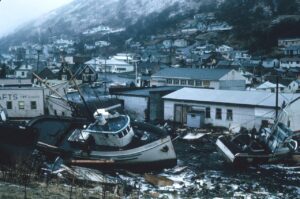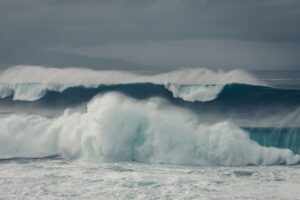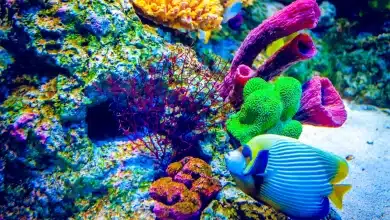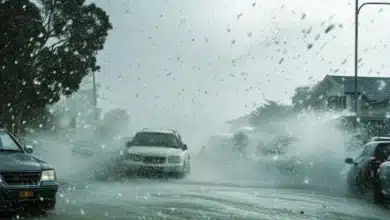How Do Tsunamis happen?
How Do Tsunamis happen?
Tsunamis are caused by winds or tides that create waves. Even while earthquakes are the most common cause of tsunamis, they may also be caused by other natural disasters such as underwater landslides, volcanic eruptions, or even meteorites.
Given that the procedure is pretty involved, let’s get started analyzing it.
What exactly is a tsunami?
The name “tsunami” originates from Japanese and means “harbor wave.” However, this does not reveal much about the nature of tsunamis, as they are not even close to being limited to ports.
A more precise title for them would be “seismic sea waves,” which also gives a more realistic description of what they are. Tsunami, on the other hand, is the term that has prevailed and is used by everyone today.
The word “tidal waves” is occasionally used to refer to them, despite the fact that this term is technically wrong and should be avoided in this context.
Although tsunamis are technically waves, their wavelengths are far longer than those of wind waves. Consider the concept of waves, but not in the context of ocean waves; rather, consider them in the context of physics.
The length of a wave’s wavelength is one of the characteristics that uniquely identify it. Wind waves have very short wavelengths and may be easily observed from the beach of any coastline. They approach every few seconds, leaving only a few meters in between each one, and occasionally even less space than that.
However, a tsunami has a very large wavelength, which is often greater than one hundred kilometers, and this is the reason why they are so hazardous (more on that a bit later). In virtually all cases, rather than appearing as a single wave, tsunamis arrive as a train of waves.
How Tsunamis form: earthquakes
Earthquakes are responsible for the formation of the great majority of tsunamis, also known as tectonic tsunamis. When an earthquake strikes, the ground beneath the water suddenly shifts upwards or downwards, and as a result, a large volume of water is displaced and begins traveling in all different directions.
This movement continues as long as the earthquake continues. This event signals the beginning of a tsunami.
The water that has been pushed about begins to flow in the form of a wave. Due to the fact that it is now situated in deep water, its amplitude is currently rather modest (earthquakes on the coastline rarely cause tsunamis). In the open sea, tsunami waves are often no more than 0.3 meters in height (12 inches).
Other tsunami causes
Landslides, volcanic eruptions, and meteorites are all possible causes of tsunamis, though these events are extremely unusual.
The fundamental idea is the same no matter what the circumstances are: a body of water is moved, and as it gets closer to the coastline, it begins to expand in height. Nevertheless, the process of displacement is distinct.
Landslides
When viewed from the ocean’s depths, landslides frequently resemble volcanoes that collapse into the water. Because this process occurs as a direct outcome of an earthquake, one may argue that an earthquake is still the primary source.
Nevertheless, earthquakes can sometimes only loosen landmass, which then begins to descend at some later point in time.
Volcanoes
There are two different ways that volcanoes might generate tsunamis. Either they will break apart completely, or they will expel materials with such force that it will elevate the water.
In the first scenario, tsunamis can be caused by land-based volcanoes as well if they are located in close proximity to the water.
Meteorites
If you’ve ever tossed a pebble into the water, you’re probably familiar with the ripples that it produces. The meteorite operates in essentially the same fashion, with the exception that it generates extremely large waves.
This sort of tsunami is extremely uncommon, although there was an incident in the year 1958 at Lituya Bay, Alaska, where a rockfall caused a wave of this kind to form.
Dangers of tsunamis
When they hit the coast, tsunamis don’t always produce enormous waves as you might expect.
According to the United States Geological Survey (USGS), the majority of tsunamis do not result in enormous breaking waves” (like normal surf waves at the beach that curl over as they approach shore). They come in more like extremely powerful and extremely quick tides (that is, a sudden rise in sea level in a certain area.
You should by this point have a very good sense of why the risk posed by tsunamis is so great.
They can move at very high speeds without losing much of their energy, and they can be very long (100 kilometers is a realistic length), very high (the tsunami that hit Japan in 2011 measured over 10 meters), and they can go very far.
An earthquake located deep inside the water has the potential to trigger several destructive tsunamis that can travel hundreds or even thousands of kilometers.
Tsunami formation process
Activation
A tsunami is caused by an earthquake, a volcanic eruption, or a landslide that occurs very far offshore. The abrupt shift on the seafloor causes the water to move in the space above it.
Even while the vertical movement could be less than a meter at first, it spreads across a broad region, and the total amount of water that is displaced is tremendous.
Build
When it reaches deeper water, the wave quickly becomes more widespread. Although it is difficult to notice at this stage since the wave is just 30 centimeters high, it is moving at more than 800 kilometers per hour.
In contrast to the typical, wind-driven waves, which have a spacing of around 100 meters between them, the crests of successive tsunami waves can be as far apart as 200 kilometers.
Formation
There is always an apex and a trough to each wave, and in the case of tsunamis, it is not uncommon for the trough to reach land first.
This results in an undesirable side effect in which the tide appears to recede by hundreds of meters further than it normally would. This disadvantage occurs around six minutes before the peak hits the coast and has the potential to catch individuals off guard.
Approach
Because of the increased amount of friction it experiences with the seafloor, the wave crest will gradually slow down as it approaches shallower water.
The more rapidly moving water that is approaching from behind builds up and pushes the wave crest far higher. Over the course of the following minute and a half, the height of the waves will continue to rise.
Conclusion
A tsunami is a sequence of gigantic waves that are caused by an undersea disturbance, which is typically related to earthquakes that occur in the ocean or around it.
A big asteroid crashing into the ocean is one of the most likely causes of a tsunami, although it may also be caused by volcanic eruptions, undersea landslides, and coastal rock falls. They are the result of a movement of the sea floor that occurs vertically, which then causes a displacement of the water mass.
Tsunami waves frequently have the appearance of walls of water, and they can strike the shoreline and remain dangerous for several hours, with new waves arriving anywhere from every five to sixty minutes.






